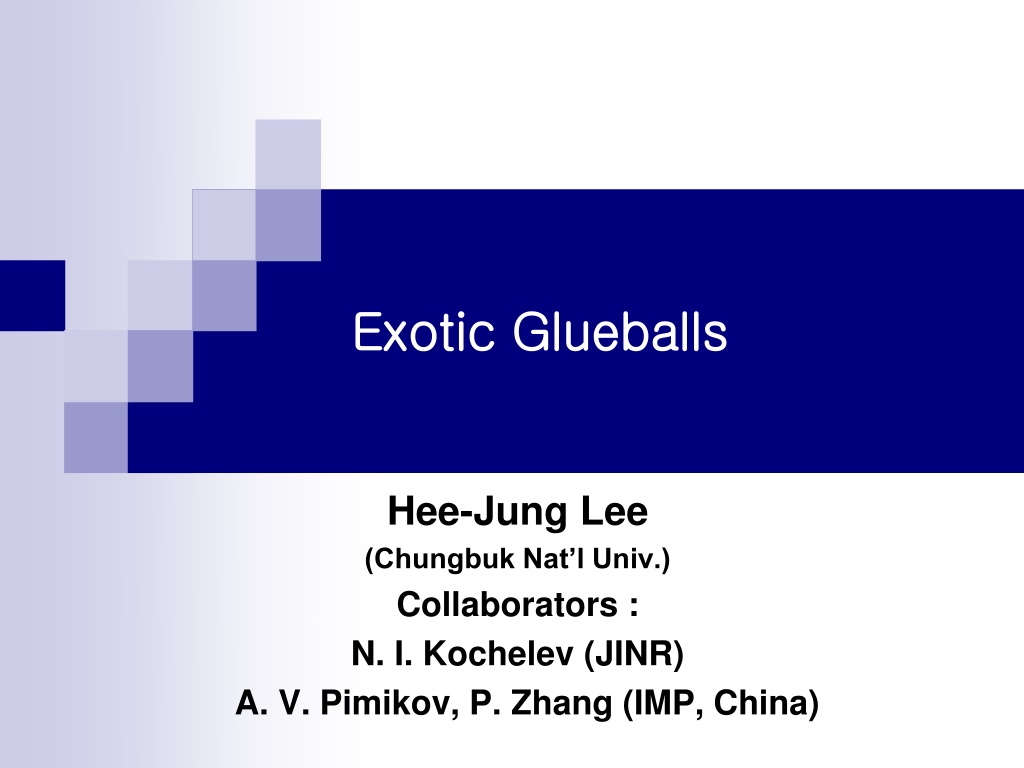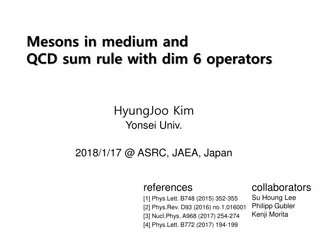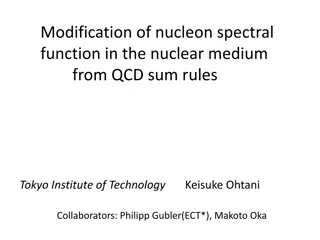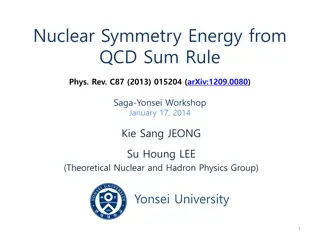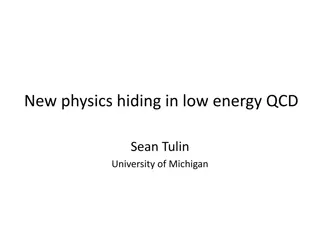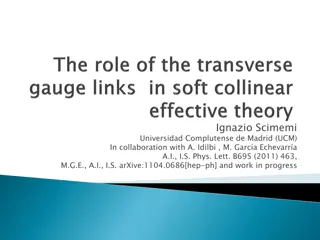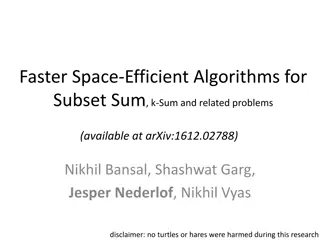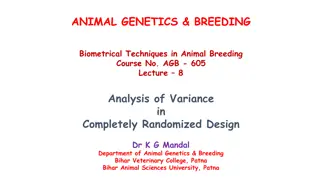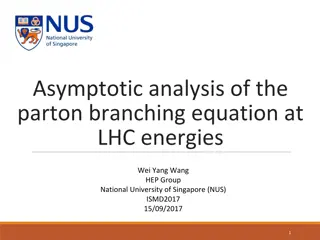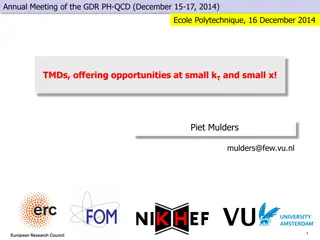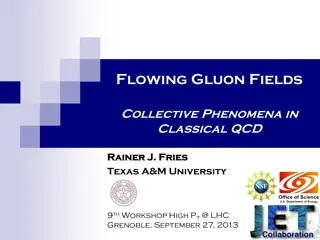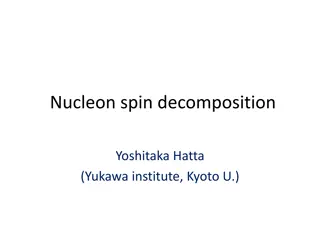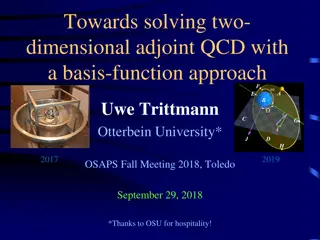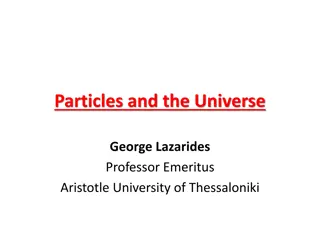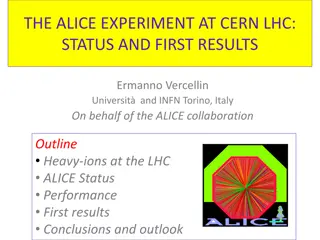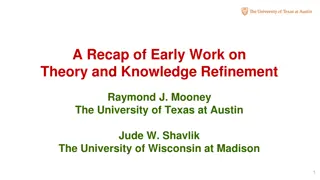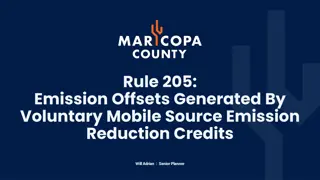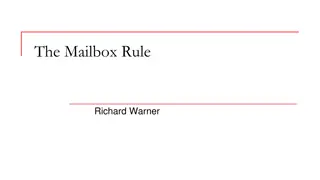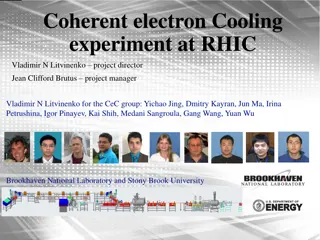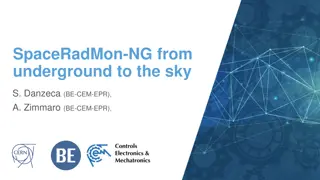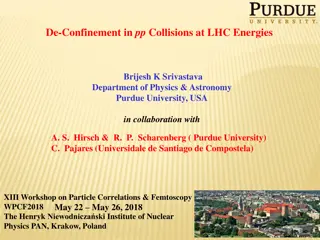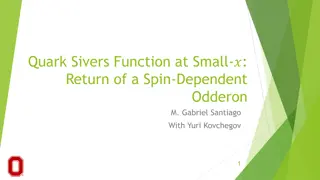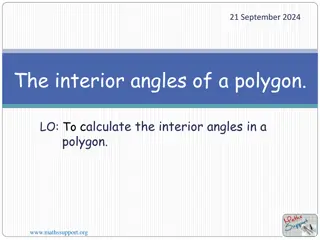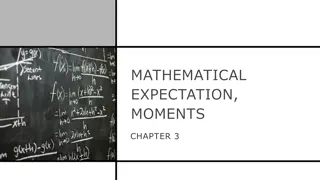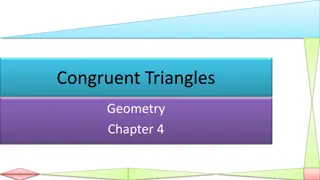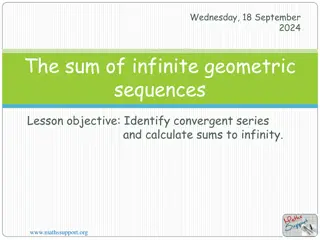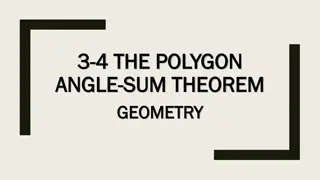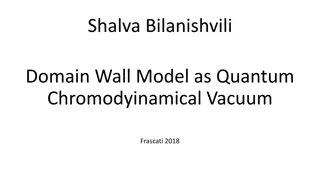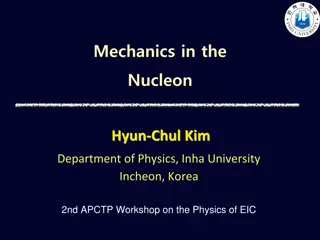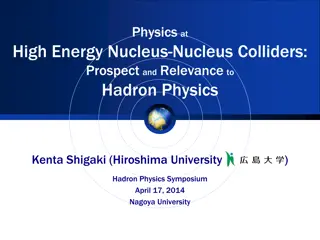Exploring Exotic Glueballs and Hadrons in QCD Sum Rule
Delve into the world of exotic glueballs and hadrons through a review of QCD sum rule, investigation of light scalar mesons, and discussion on hadrons with unconventional quantum numbers. Learn about theoretical frameworks and calculations involving correlators, dispersion relations, Borel transforms, and mass determinations of particles. Discover the intriguing realm of exotic hadrons beyond the traditional quark model.
Download Presentation

Please find below an Image/Link to download the presentation.
The content on the website is provided AS IS for your information and personal use only. It may not be sold, licensed, or shared on other websites without obtaining consent from the author. Download presentation by click this link. If you encounter any issues during the download, it is possible that the publisher has removed the file from their server.
E N D
Presentation Transcript
Exotic Glueballs Exotic Glueballs Hee-Jung Lee (Chungbuk Nat l Univ.) Collaborators : N. I. Kochelev (JINR) A. V. Pimikov, P. Zhang (IMP, China)
In this talk Exotic hadrons? Review of the QCD sum rule Review of the light scalar meson nonet as the exotic meson Exotic glueballs within the QCD sum rule Discussion
Exotic Hadrons? Hadrons of quantum numbers which are not expected from the conventional quark model for hadrons (Baryons of 3 quarks, mesons of quark and antiquark). - Examples : mesons of JPC=0--, 1-+ P=-(-1)L, C=(-1)L+S Hadrons which are expected to have more quark content than the conventional hadrons have. - Example : tetraquark states for the light scalar mesons
PDG 2016 PDG 2016
QCD sum rule (SR) Correlator of the interpolating current with the quantum number of the hadron under consideration S J i d x e Nonperturbative QCD Vacuum = iq x 2 4 S ( ) 0| ( ) x J (0)|0 q TJ S S Calculating it in deeply Euclidean region by the perturbative OPE Condensates from the nonperturbative vacuum 2 OPE S ( ) : q
OPE 2 ( ) q is related to physical region by the dispersion relation 1 ( ) S q 2 Im ( ) s q = 2 2 OPE S ds 2 2 s 0 Narrow resonance approx. in the phen. side Quark Quark- -hadron duality hadron duality = 4 S 0| | 2 J S f M S S = + 2 2 8 S 2 2 S 2 2 0 2 OPE S Im ( ) s 2 ( ) ( )Im ( ) s f M s M s s S S threshold = ) 0| n n J 2 2 2 n S Im ( ) ( (0)| | (0)|0 q q m J S S n
Borel transform makes the contributions from the continuum suppressed exponentially. QCD sum rules : 2 0 s 2 S 2 2 2 = / M M 2 / 2 2 8 S s M OPE S Im ( ) s 2 ds e f M e 1 S 0 LHS(M) : Must be Must be POSITIVE POSITIVE : Borel Mass M
Mass of Particle can be determined by = 3 ( /2 ) M M S M S S Generally, including all contributions from OPE, the mass must be independent on the Borel mass, if the current is appropriate to the hadron. Actually, we cannot do it. Up to a certain energy dimension operators, mass plateau appears in some region of the Borel mass. Borel window Borel window must be opened in . M s 0
Light scalar meson nonet Members : = = = 0 0 1 : , ( 980 ) I a a 0 0 0 1/2 : 0 : (500), , , f (8 980 00) ) I I ( 0 Large decay widths : = = 50 ~100MeV, = 40 ~100MeV a f 0 0 400 ~ 700MeV Refs. : PDG, Chin. Phys. C, 38(2014) 09001
interpretation qq L=1 With ideal mixing : for P=+1 1 + = = = 0 0 (980) , ( ), a u d a uu dd a du 0 0 2 + = = = = 0 0 (800) , , , us ds sd su 1 (600) = + = ( ), (980) ss uu d d f ss 0 2 0a (?1)Decays of : fraction of ? + [ (980) [ (980) a ] a = 0.85 0.02 Amsler et al, Phys. Rep. 384(2004)61 0 ] KK 0
(?2) Mass degeneracy in 1. From number of strange quarks m L = , a f 0 0 0, a m m m f 0 2. gives 400MeV more mass : from the mass formula in a quark model (Kochelev, H.-J. Lee, Vento, PLB 594 (2004) 87), for example : f 1 0(980)
interpretation [ ][ ] qq qq One gluon exchange & instanton : strongest attraction in two quarks of : scalar (S) diquark in two antiquarks of : S antidiquark -Jaffe & Wilczek, Shuryak & Zahed Jaffe & Wilczek, Shuryak & Zahed S | 3 ,3 ,1 F C S |3 ,3 ,1 F C In flavor space : = = 3 3 3 6 , 3 3 3 6 f f A = S f f A S 3 3 1 8 A A Explicitly [ ] , [ ] , [ ] ud s us d ds u A A A [ ] , [ ] , [ ] ud s us d ds u A A A
In terms of S diquark & S antidiquark : L=0 1([ 2 us ud + = = ] [ = 0 0 (980) [ ][ ], ][ ][ ]) , [ ][ ] a ds us a ds ds us us a us ds 0 0 + = = = = 0 0 (800) [ ][ ], [ ][ ], [ ][ ], [ ][ ] ds ud ud us u d ds 1 (600) = = ] [ + [ ][ ], (980) f ([ ][ ][ ] ) ud u d ds ds u s us 0 2 Number of strange quark : = m m m m : Inverted mass spectrum Inverted mass spectrum f a 0 0 , f a Strange quark component in : 0 0 , f a KK 0 0
SRs for light scalar nonet Interpolating currents : energy dim.=6 After Borel transform : Energy dimension of the correlator =10
QCD SR : and up to u m = = 0 m ( ) O m d s = + + 10 6 4 S S S ( ) M C O M E C O M E C O M E 0 0 4 4, 4, 2 6, 6, f M e 1 S i i i i 2 S 2 + + + + = / M M 2 2 2 8 S S S S / 2 C O M E C O C M 8, 8, 0 10, 10, 12, i i i i i S Continuum contributions : 1 1) 2 0 s 2 = / x M n ( ) E M dx e x n + + 2 2 n ( n M 0 Physical Borel region is around 1GeV : operators up to dim=8 would be important
LHS of SRs with scalar Diquark , f a 0 0
What we have seen SRs up to d=6 ops. : - Multiquark system has large energy dim. : SRs up to d=6 ops. could not be enough. Large negative contribution from d=8 ops. : destroys consistency of SRs. Effect from Instanton?
Any possibility for keeping consistency of SRs? Generally, five types of relativistic currents : = i S T A i T A i 3 3 : C [ ] [ ] J q q q q 1, 2, ] ( + 3, b 4, q C abc q b c ade a d e = ] ( + i S T S i T S i 6 6 : C {[ )}{[ )} J q q a b 1, 2, 3, 4, C a b a b = = = A T i A i S T i S i , , with , and , 0 0 = A i ( ), ( S ), ( ) V C C PS C 5 5 = S i ( ), ( ) T C AV C General interpolating currents : S S S J J = + + + + PS S V S AV S T S ' J vJ v J tJ Chen et al., Phys.Lett.B650:369-372,2007
SR for f0(500) again t Hooft instanton induced interaction for u,d : Fierz trans. Fierz trans. = = = = = = 1 , 1 , 0 , ' 0 , 1/4 for 3 v v t N C
Including instanton effects, for a=-b=1, there can be stable result!
Exotic Glueballs Glueballs, bound states of gluons, are predicted by QCD and have been studied for a long time. There has been no clear experimental evidence. Theoretically, the glueballs of the two or three gluons with the quantum numbers, 0-+, 0++, 2++ have been studied mainly. Masses of 0-+, 0++glueballs of two gluons from the QCD SR : - Mathieu, Kochelev, Vento, IJMP(2009)
These glueballs could couple to the conventional mesons of 0-+, 0++. This fact could be one of difficulties in searching the glueballs in experiments! If glueballs of the exotic quantum numbers exist, those glueballs will not couple to the conventional mesons. One candidate for such kinds of the exotic glueballs is the glueball with of three gluons.
glueball within QCD SR Current of three gluons - Under the charge conjugation and the parity - Current will have a form, depending on Oi,
First attempt : Qiao and Tang, PRL (2014) - Current : - It is checked that the imaginary part of the correlator within OPE is NEGATIVE. So?? - LHS of SR becomes NEGATIVE : No bound states in these kinds of three gluons. This discussion will be appeared on PRL comm.
Our analysis : PRD (2017) New current : - Leading part is
Various contributions to : - 6 types of correlators are appeared. - Example : - Diagrammatic representations :
Correaltor within OPE : : POSITIVE Imaginary part. : No Im., for J=0 : Negative Im. :By Hyp. Vac. Dom.
Mass and Decay constanat : - with From lattice, Gregory JHEP(2012) :
Discussion We reviewed that f0(500) could be the bound state of the diquark-antidiquark. It was also discussed that interactions between the diquarks and antidiquarks played an important role in QCD sum rule analysis. We showed that the exotic 0--glueball could be understood within the QCD sum rule. - Will this exotic glueball not couple to the exotic meson? : 0--tetraquark has mass ~1.6GeV (Huang et al, PRD(17)) - It looks that we were lucky to find a good current for it. - So, it is necessary for us to construct the current by more systematic way as in the case of f0(500) : under the progress. Thank you!
